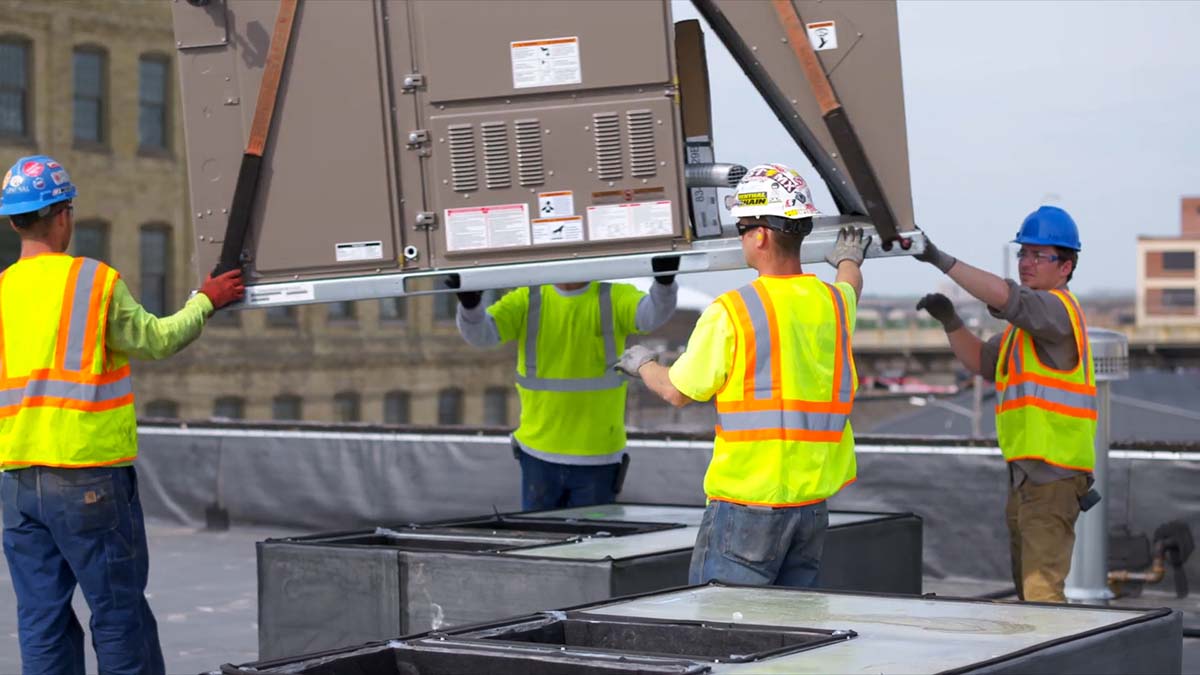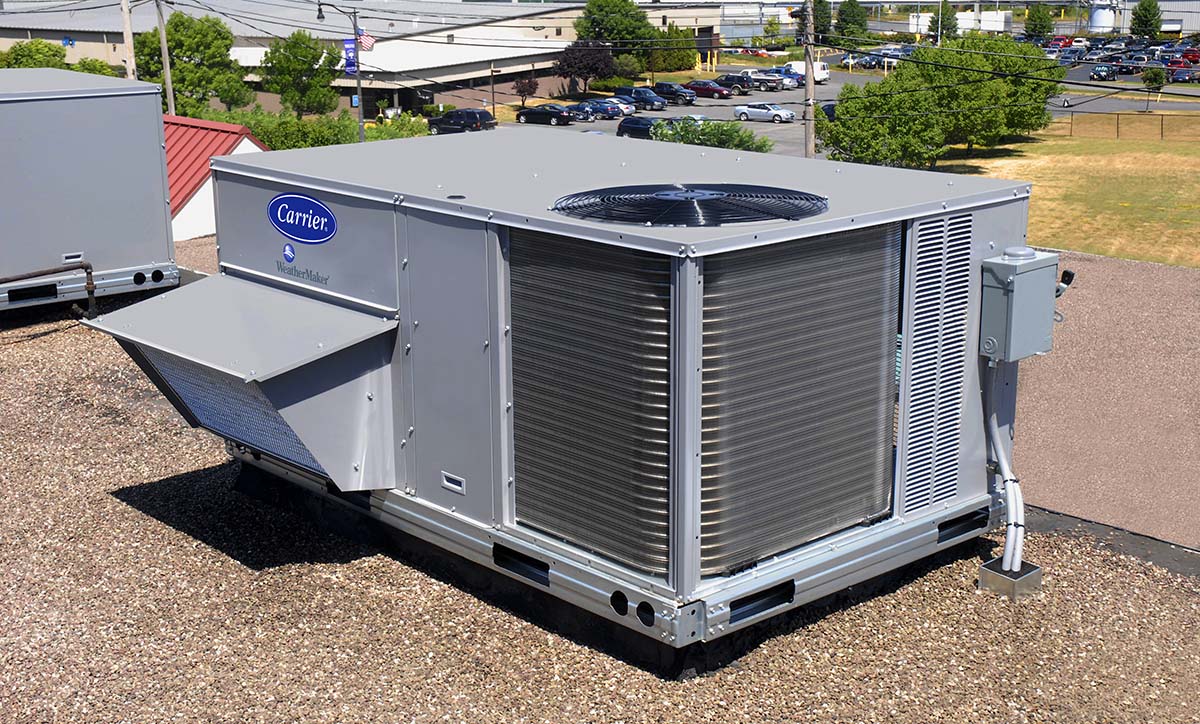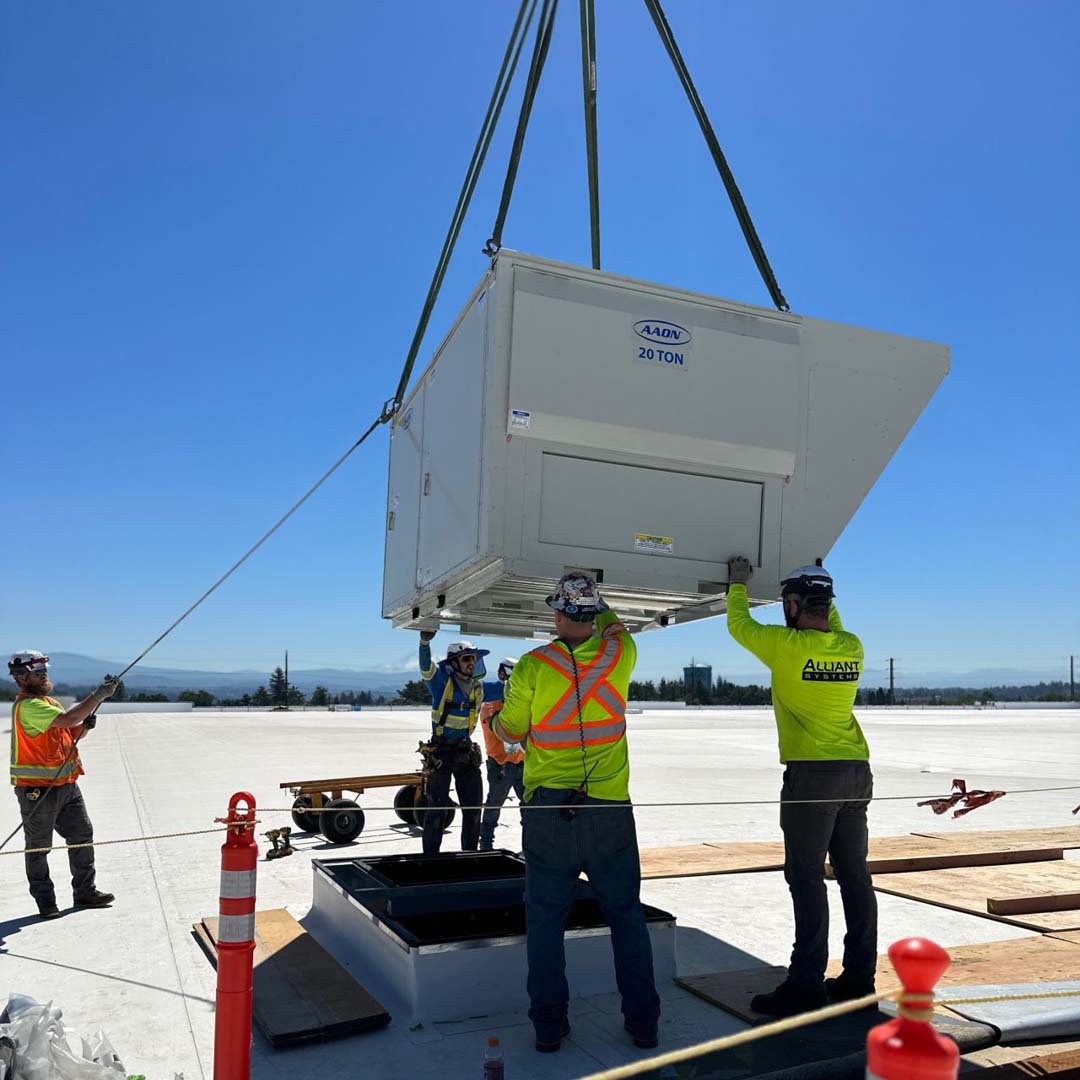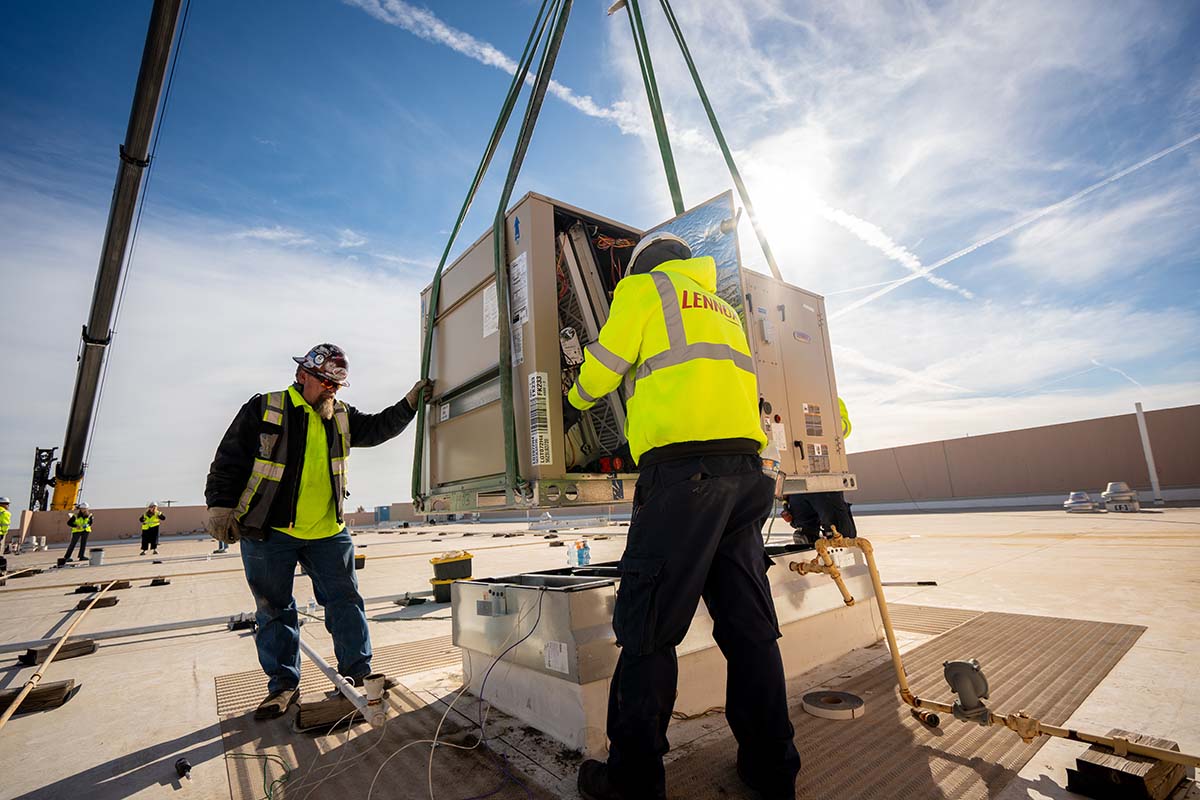✕
Following its 2021 residential Cold Climate Heat Pump (CCHP) challenge, the Department of Energy (DOE) recently launched a similar program for commercial rooftop heat pumps. The DOE’s Commercial Building Heat Pump Accelerator program, introduced earlier this year, encourages manufacturers to produce more efficient and cost-effective heat pump rooftop units (RTUs) suitable for cold climates by December 2027.
According to the DOE, heat pump RTUs can cut GHG emissions and energy costs by up to 50% compared to conventional RTUs with natural gas heating. Yet despite growing demand, fewer than 15% of U.S. commercial buildings use heat pumps, and adoption is even lower in cold climates, where commercial equipment performance and availability lag behind residential systems.
Through the new program, DOE is working with key stakeholders — including AAON, Budderfly, Carrier Global Corp., Lennox Intl., Rheem Mfg. Co., Trane Technologies, and York Intl. Corp. — to develop and deploy next-generation heat pump RTU technology. The program also includes commercial retailers such as Amazon, IKEA, and Target, which have pledged to evaluate and adopt the new heat pump RTUs once they become available.
Natural Extension
DOE’s RTU Accelerator program is a natural extension of the residential CCHP challenge, which is why many manufacturers involved in the latter also joined the rooftop challenge. As Philip Smyth, executive director of commercial product management at Johnson Controls, noted, “Through our partnership with the DOE CCHP challenge, we have developed technologies that can maintain efficiency within low ambient temperatures for the residential market. Now we’re applying those advancements to the commercial market as well.”

LOW-GWP REFRIGERANT: Johnson Controls has committed to using low-GWP refrigerant R-454B in the RTU challenge in order to minimize environmental impact and enhance energy efficiency. (Courtesy of Johnson Controls)
Smyth added that the Accelerator program provides a framework for manufacturers to reimagine packaged heat pump performance, while providing a set of uniform performance benchmarks. “With these targets, commercial customers can be assured heat pump RTUs are a proven, efficient solution for colder climates,” he said.
Carrier chose to participate in the program in order to continue its commitment to innovation, which aligns perfectly with the DOE’s Accelerator goals of promoting more efficient and affordable next-generation equipment, said Heidi Gehring, managing director of light commercial at Carrier.

CORE CONTROL: Carrier is participating in the DOE’s Accelerator program in order to continue its commitment to innovation. (Courtesy of Carrier)
“This Accelerator program aims to expand heat pump functionality to areas where there have been diminishing returns on heating,” she said. “The advancement in heat pump technology will allow significant increases in the adoption of heat pumps to further electrification initiatives and reduce reliance on fossil fuel-based heating solutions.”
Indeed, an increasing number of commercial customers want decarbonization options, which is why Trane Technologies decided to participate in the challenge, said Jeremy Brown, director of engineering – unitary, commercial HVAC Americas, at Trane Technologies.
“This new initiative is designed to help advance the adoption of cost-effective, next-generation heat pump rooftop units and cut carbon emissions,” said Brown. “Following our industry-leading performance in DOE’s residential CCHP challenge, we wanted to bring our expertise to commercial heat pumps through the Accelerator program.”
For energy-as-a-service company (EaaS), Budderfly, the Accelerator program aligns perfectly with its goal of introducing next-generation heat pump technology to the middle market — a segment often overlooked in the energy transition due to cost barriers and limited access to capital, said Matthew Nemerson vice president of strategy partnerships at Budderfly.
“The Accelerator program promotes the development and adoption of higher-efficiency heat pump units, which can significantly reduce energy costs and carbon emissions,” he said. “For end users, these new heat pumps offer substantial benefits, including lower utility bills, reduced environmental impact, and improved operational efficiency. And with our EaaS model, customers can benefit from these advanced technologies without upfront costs.”
Lennox Commercial’s decision to participate in the DOE program came from the desire to create products that not only meet the market’s evolving needs, but also enhance the sustainability of their offerings, said Tate Byers, senior product manager at Lennox Commercial HVAC.
“Cold-climate heat pumps offer a new solution to the market that can greatly expand where heat pumps can be applied across North America,” he said. “That’s one of the biggest benefits, since traditionally heat pumps are restricted by their mechanical heating capacity in the winter.”
– Karthig Kathirvel
senior manager of engineering and product development
Rheem
Technologies and Timelines
Many manufacturers are eagerly taking on the challenge to advance the limits of current rooftop technologies. In fact, commitment to innovation is one of the reasons why AAON chose to join the Accelerator program.

NEW TECHNOLOGIES: As part of DOE’s RTU challenge, AAON is analyzing compressor technologies such as variable speed and vapor injection. (Courtesy of AAON)
“In the current market, there is a significant demand for heat pumps that can deliver higher heating capacity at lower temperatures,” said Kevin Teakell, senior manager of government and industry affairs at AAON. “By participating in this program, AAON aims to push the boundaries of current technology and develop products that not only meet but exceed these demands. This aligns with our mission to innovate and provide cutting-edge solutions in the HVAC industry.”
This innovation is essential, as traditional heat pumps often fall short in providing sufficient heat in cold climates, requiring backup or supplemental heating solutions like gas furnaces or electric strip heaters.
“The use of electric strip backup heat usually increases the amp requirement considerably and can even double the amps required versus a traditional heat pump or air conditioner with a gas furnace, depending on the ambient temperatures,” said Teakell. “This can lead to very expensive electrical infrastructure upgrades for replacement equipment. Meeting the requirements of the Accelerator program will greatly reduce the use of backup and supplemental heat, depending on location.”
Unfortunately, increasing efficiency or capacity usually requires some combination of larger coils, more complicated control systems, or more complex refrigeration systems, said Teakell. “AAON is weighing all these options in order to keep the cost and size impacts to a minimum.”
Innovation is also one of the reasons why Rheem became involved in the Accelerator program, said Karthig Kathirvel, senior manager of engineering and product development at Rheem. “The program challenges manufacturers to develop heat pump rooftop units that are optimized for cold climates and which meet advanced technology specifications.”
To that end, Rheem is working with its supplier partners to leverage cutting-edge technologies that optimize heat transfer, compressor performance, and overall performance through intelligent controls, said Kathirvel.
“Rheem recognizes the importance of making heat pump technology accessible to a broader audience, especially within the packaged rooftop market, which provides heating to a majority of commercial spaces in the U.S.,” he said. “Therefore, affordability is a key driver in our innovation efforts. The company is working on cost-effective designs, manufacturing processes, and materials to ensure that the resulting rooftop heat pumps are competitively priced.”
Johnson Controls also understands that affordability is a crucial factor, which is why the company is prioritizing it as a way to create a realistic path to sustainability, said Smyth.
“Using the proven technology of our existing rooftop unit portfolio as a baseline, our engineers are also examining how we can modify the refrigeration system to achieve higher efficiencies in lower ambient temperatures,” noted Smyth. “As a part of this process, defrost cycles and dual fuel system integration are important considerations. Many of these innovations rely heavily on advanced controls, such as Johnson Controls Metasys Building Automation System.”
At Carrier, multiple innovations in compression, controls, and heat exchangers are being used to support the Accelerator program, said Gehring.
“All will contribute to efficiency level and heating performance with the goal of extending heat pump performance into more climate zones. In addition, integrated controls with diagnostic capabilities will be designed to provide superior performance and improve the user experience during startup, operation, and service.”
According to Byers, controls are also part of Lennox’s strategy. He noted that their rooftop heat pumps will feature the Lennox CORE unit controller, which will optimize the performance of the heat pump based on the operating conditions.

CORE CONTROL: Lennox’s rooftop heat pumps will feature the CORE unit controller, which optimizes the performance of the RTU based on the operating conditions. (Courtesy of Lennox)
Trane is currently exploring several innovative solutions for its program-compliant heat pump RTUs, but one thing’s for sure — all of them will be equipped with Symbio unit controls, said Brown. “These controllers enable digitally connected smart buildings by allowing servicers and building owners to remotely monitor, troubleshoot, schedule, and control equipment. Symbio unit controllers also help maximize energy efficiency, streamline equipment startup, and improve serviceability.
So when can contractors expect to see these cold climate heat pump RTUs on the market? Not for a few years. DOE has not yet finalized the specific requirements for the Accelerator program (see sidebar), but it has outlined a proposed timeline for its implementation.
“By June 2025, the prototype units are set to undergo rigorous validation in DOE laboratories, ensuring compliance with safety, performance, and reliability standards,” said Dr. Harshad Inamdar, senior principal research engineer at Rheem. “Subsequently, in September 2025, field trials will commence, evaluating the units in real-world scenarios for effectiveness, scalability, and practicality. As for commercial availability, the DOE aims to make them accessible as early as November 2027. The scope of this challenge spans a nominal capacity range from 6 to 25 tons, making these products a suitable choice for a wide range of commercial buildings.”
New Metrics
As noted earlier, DOE is still in the process of finalizing the requirements for the Accelerator program, which will include energy efficiency guidelines that will likely incorporate new metrics that may be unfamiliar to many in the HVAC industry.
The current heating metric for air-source heat pumps is the coefficient of performance (COP), which measures heating capacity to power input at a single test condition of 47°F. However, COP doesn’t account for part-load performance or varying temperatures throughout the heating season, nor does it include energy use in ventilation mode. The proposed new metric — Integrated Ventilating and Heating Efficiency (IVHE) — considers both full- and part-load operations across a range of typical ambient temperatures and includes energy use in heating season ventilation mode.
“Beginning January 1, 2029, the DOE will require the new IVHE heating metric, which is an annualized heating metric that is the weighted national average of commercial buildings in the U.S.,” said Kevin Teakell, senior manager of government and industry affairs at AAON. “DOE is currently proposing to use the new IVHEC metric in the Accelerator program, which is the heating metric used for cold climates and is an average of commercial buildings in climate zones 5-8.”
The current cooling metric required by DOE is the Integrated Energy Efficiency Ratio (IEER), but that will change on January 1, 2029, as well, said Teakell. “The DOE will require a new cooling metric called Integrated Ventilation, Economizer, and Cooling (IVEC), which DOE is proposing to use as the cooling metric in this challenge. The challenge IVHEC and IVEC requirements have not yet been finalized.”
Whether you require installation, repair, or maintenance, our technicians will assist you with top-quality service at any time of the day or night. Take comfort in knowing your indoor air quality is the best it can be with MOE heating & cooling services Ontario's solution for heating, air conditioning, and ventilation that’s cooler than the rest.
Contact us to schedule a visit. Our qualified team of technicians, are always ready to help you and guide you for heating and cooling issues. Weather you want to replace an old furnace or install a brand new air conditioner, we are here to help you. Our main office is at Kitchener but we can service most of Ontario's cities
Source link


Add Comment